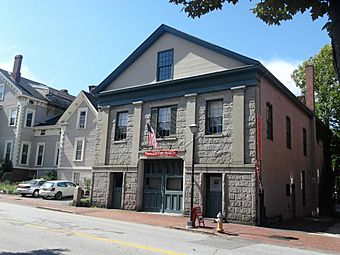Spring Street Historic District facts for kids
Quick facts for kids |
|
|
Spring Street Historic District
|
|

The Portland Fire Museum building in September 2011
|
|
| Location | Forest, Oak, Danforth, Brackett and Pine Streets, Portland, Maine |
|---|---|
| Area | 75 acres (30 ha) |
| Architectural style | Federal, Mixed |
| NRHP reference No. | 70000043 |
| Added to NRHP | April 3, 1970 |
The Spring Street Historic District is a special part of Portland, Maine. It holds many buildings that survived a huge fire in 1866. This area shows what Portland looked like in the 1800s. It has both homes and businesses from that time. The district is part of Portland's Arts District and its West End. It was added to the National Register of Historic Places in 1970. This means it is a place important to the history of the United States.
Exploring the Spring Street District
This historic district covers about 75 acres. It is located in the heart of Portland. The area is bordered by streets like Danforth and Brackett Streets. It also reaches parts of Pine Street and Forest Avenue. The district includes a mix of old homes and commercial buildings. Many of these buildings were built before the big fire of 1866. This fire destroyed much of Portland.
Famous Buildings and Their Stories
The Spring Street Historic District is home to many interesting old buildings. Each one has its own story.
- The Charles Q. Clapp House is a beautiful old home.
- The McLellan-Sweat Mansion is another grand house. It is now part of the Portland Museum of Art.
- The Park Street Church was built in 1833. It is a historic place of worship.
- The old fire station is also here. It now houses the Portland Fire Museum. You can learn about firefighting history there.
- The home of writer John Neal is in this district.
- The home of Prentiss Mellen was later changed into a monastery.
- An old mansion from 1805 was designed by Alexander Parris. It later became the Portland Club.
- The Charles Q. Clapp Block is a unique commercial building. It has a flatiron shape.
- The Victoria Mansion is a very famous building. It was built in 1860. This beautiful Italian-style house is now a museum.
Many of these buildings were built when Portland was growing fast. They show the city's success before the 1866 fire.
Protecting Portland's Historic Buildings
In 1988, people in Portland worked hard to protect old buildings. There was a plan to tear down a building from 1857 on Park Street. Some people, including a local leader named James V. Oliver, tried to stop this. They wanted to save the historic building.
Because of these efforts, Portland's City Council made a new rule. This rule made it much harder to tear down buildings in historic areas. It meant that buildings in places like the Spring Street Historic District could not be destroyed. The only exception was if a building was unsafe and could not be used anymore. This new rule helped protect Portland's valuable history for future generations.



